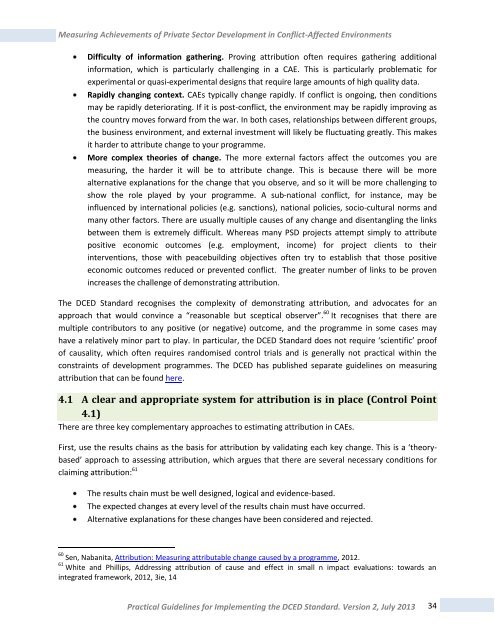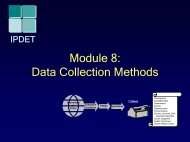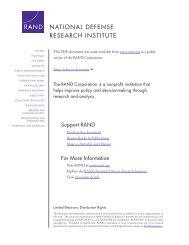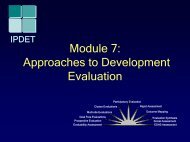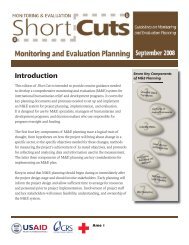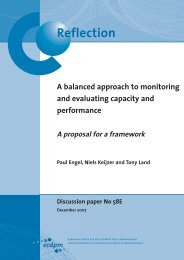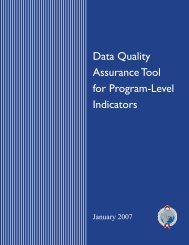Measuring Achievements of Private Sector Development in ... - DCED
Measuring Achievements of Private Sector Development in ... - DCED
Measuring Achievements of Private Sector Development in ... - DCED
Create successful ePaper yourself
Turn your PDF publications into a flip-book with our unique Google optimized e-Paper software.
<strong>Measur<strong>in</strong>g</strong> <strong>Achievements</strong> <strong>of</strong> <strong>Private</strong> <strong>Sector</strong> <strong>Development</strong> <strong>in</strong> Conflict-Affected Environments<br />
Difficulty <strong>of</strong> <strong>in</strong>formation gather<strong>in</strong>g. Prov<strong>in</strong>g attribution <strong>of</strong>ten requires gather<strong>in</strong>g additional<br />
<strong>in</strong>formation, which is particularly challeng<strong>in</strong>g <strong>in</strong> a CAE. This is particularly problematic for<br />
experimental or quasi-experimental designs that require large amounts <strong>of</strong> high quality data.<br />
Rapidly chang<strong>in</strong>g context. CAEs typically change rapidly. If conflict is ongo<strong>in</strong>g, then conditions<br />
may be rapidly deteriorat<strong>in</strong>g. If it is post-conflict, the environment may be rapidly improv<strong>in</strong>g as<br />
the country moves forward from the war. In both cases, relationships between different groups,<br />
the bus<strong>in</strong>ess environment, and external <strong>in</strong>vestment will likely be fluctuat<strong>in</strong>g greatly. This makes<br />
it harder to attribute change to your programme.<br />
More complex theories <strong>of</strong> change. The more external factors affect the outcomes you are<br />
measur<strong>in</strong>g, the harder it will be to attribute change. This is because there will be more<br />
alternative explanations for the change that you observe, and so it will be more challeng<strong>in</strong>g to<br />
show the role played by your programme. A sub-national conflict, for <strong>in</strong>stance, may be<br />
<strong>in</strong>fluenced by <strong>in</strong>ternational policies (e.g. sanctions), national policies, socio-cultural norms and<br />
many other factors. There are usually multiple causes <strong>of</strong> any change and disentangl<strong>in</strong>g the l<strong>in</strong>ks<br />
between them is extremely difficult. Whereas many PSD projects attempt simply to attribute<br />
positive economic outcomes (e.g. employment, <strong>in</strong>come) for project clients to their<br />
<strong>in</strong>terventions, those with peacebuild<strong>in</strong>g objectives <strong>of</strong>ten try to establish that those positive<br />
economic outcomes reduced or prevented conflict. The greater number <strong>of</strong> l<strong>in</strong>ks to be proven<br />
<strong>in</strong>creases the challenge <strong>of</strong> demonstrat<strong>in</strong>g attribution.<br />
The <strong>DCED</strong> Standard recognises the complexity <strong>of</strong> demonstrat<strong>in</strong>g attribution, and advocates for an<br />
approach that would conv<strong>in</strong>ce a “reasonable but sceptical observer”. 60 It recognises that there are<br />
multiple contributors to any positive (or negative) outcome, and the programme <strong>in</strong> some cases may<br />
have a relatively m<strong>in</strong>or part to play. In particular, the <strong>DCED</strong> Standard does not require ‘scientific’ pro<strong>of</strong><br />
<strong>of</strong> causality, which <strong>of</strong>ten requires randomised control trials and is generally not practical with<strong>in</strong> the<br />
constra<strong>in</strong>ts <strong>of</strong> development programmes. The <strong>DCED</strong> has published separate guidel<strong>in</strong>es on measur<strong>in</strong>g<br />
attribution that can be found here.<br />
4.1 A clear and appropriate system for attribution is <strong>in</strong> place (Control Po<strong>in</strong>t<br />
4.1)<br />
There are three key complementary approaches to estimat<strong>in</strong>g attribution <strong>in</strong> CAEs.<br />
First, use the results cha<strong>in</strong>s as the basis for attribution by validat<strong>in</strong>g each key change. This is a ‘theorybased’<br />
approach to assess<strong>in</strong>g attribution, which argues that there are several necessary conditions for<br />
claim<strong>in</strong>g attribution: 61<br />
The results cha<strong>in</strong> must be well designed, logical and evidence-based.<br />
The expected changes at every level <strong>of</strong> the results cha<strong>in</strong> must have occurred.<br />
Alternative explanations for these changes have been considered and rejected.<br />
60 Sen, Nabanita, Attribution: <strong>Measur<strong>in</strong>g</strong> attributable change caused by a programme, 2012.<br />
61 White and Phillips, Address<strong>in</strong>g attribution <strong>of</strong> cause and effect <strong>in</strong> small n impact evaluations: towards an<br />
<strong>in</strong>tegrated framework, 2012, 3ie, 14<br />
Practical Guidel<strong>in</strong>es for Implement<strong>in</strong>g the <strong>DCED</strong> Standard. Version 2, July 2013<br />
34


